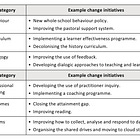Values mapping | Calling all slice teams!
Moving toward your values - and away from their opposites
Before we dive in to today's post on values-led decision-making, two quick announcements:
1. Calling all slice teams!
As regular readers will be aware, slice teams are the big idea that sits at the heart of the Making Change Stick programme:
In case you’re new to this idea, a slice team is when you have a cross-section of the school community so you have different types of people – representatives of different stakeholder groups, if you like – sitting around the decision-making table together.
There are two main advantages to implementing change using a slice team:
You create much better policy.
You get buy-in like never before.
Now that the the book is out and the word is spreading (!), I’d love to gather a few case studies showing how schools (and other organisations) are using slice teams in practice – no matter how big or small the initiative.
So. If you’ve worked with a slice team in your school or organisation, please drop me a line with ‘Slice team’ in the subject line, and a sentence or two describing what you did and the impact it had. It will take 2-3 minutes of your time and I would be eternally grateful.
2. Implementation science hits Hong Kong!
I was contacted recently by Chris Jordan, an English teacher and host of the Leading, Language and Literature podcast based in Hong Kong. Chris has read both my books - Making Change Stick and Fear is the Mind Killer - as well as several of my blogs - and has thought hard about how they apply to his work.
So we had a delightful conversation on his podcast combining my two favourite topics - self-regulated learning and implementation science! Among much else, we discussed:
The distinction between metacognition, self-regulation and self-regulated learning
How to sequence the instruction of self-regulated learning
Whether self-regulated learning should be taught separately or embedded across the curriculum
The extent to which the Making Change Stick programme is relevant to department heads as well as senior leaders (spoiler: a lot!)
Key scholars and seminal texts in the change management literature
Tune in here - or wherever you get your podcasts!
OK, let's do this…
Values mapping
This is the third post in a short series on how to choose your focus when everything feels like a priority. The response to the first two posts has been amazing – thanks so much to everyone who has commented.
By way of a reminder, here are the previous two posts in case you missed them:
And the conversations these sparked over on LinkedIn - here and here - are well worth a look.
So far, we’ve:
Used a needs analysis to generate a long-list of potential improvement initiatives.
Used a priority matrix to sort them by effort and impact.
Today we’re adding a third lens: values mapping.
Why values (and their opposites) matter
Most schools proudly list their values on their websites and reference them in assemblies, at open evenings and in their prospectuses. Often, these words adorn school corridors in oversized fonts.
Here are some examples of the kinds of values that schools often espouse:
Altruism
Collaboration
Compassion
Doing your best
Empathy
Friendship
Generosity
Honesty
Integrity
Kindness
Perseverance
Resilience
Respect
Responsibility
Service
Wisdom
This is all well and good. However, as Guy Claxton has noted, when you look at what schools do on a day-to-day basis, it isn’t always immediately obvious how such values play out in practice.1
Part of the problem is that values are a bit ‘motherhood and apple pie’ – few people would argue against any of the lovely-sounding things in the list above.
According to Higham and Booth, values are ‘deep-seated beliefs and commitments that operate as motives for right action; as well as providing a sense of direction, they influence decisions in the moment.’2
So if you want to know what your school’s values really are – don’t ask people what they believe. Watch what they do.
Booth and Ainscow suggest that if you really want to understand values, you need to look at their opposites.3
There are no right answers here, but the opposites of the values listed above might be something like the following:
Altruism → Selfishness
Collaboration → Wanting to win
Compassion → Cynicism
Doing your best → Disengagement
Empathy → Indifference
Friendship → Hostility
Generosity → Hoarding
Honesty → Manipulation
Integrity → Hypocrisy
Kindness → Bitterness
Perseverance → Helplessness
Resilience → Fragility
Respect → Rudeness
Responsibility → Recklessness
Service → Hindrance
Wisdom → Thoughtlessness
How to run a values mapping exercise
Write down a list of your core values and their opposites. If you’re in a group, you may wish to do this exercise individually and then compare notes and create a shared version.
Return to your list of potential significant projects (generated in the exercises in the previous two posts) For each, ask:
How will this project help us promote our values?
How will it help us reduce their opposites?
For example, you might say:
Our new behaviour and relationships policy will:
Promote the values of respect, responsibility and kindness.
Reduce rudeness, selfishness and indifference.
Our new learner effectiveness programme will:
Promote the values of collaboration, service and perseverance.
Reduce helplessness, fragility and disengagement.
Our new peer mentoring system will:
Promote the values of friendship, empathy and honesty.
Reduce hostility, cynicism and manipulation.
The overarching question here is: which of our potential school improvement initiatives is best suited to helping us live out our values as a school? Discussing this question within your team should help clarify your thinking and help you identify the best option for you to focus on. Following this exercise, you may wish to alter the position of some of the sticky notes on your priority matrix.
By now, you may have a clear front-runner – a high-effort, high-impact project that is strongly aligned with your values – and you may be straining at the leash to get started.
Before you make your final decision, however, there’s one more exercise to complete – one that often makes people see things in an entirely new light.
We’ll look at this next time.
Discussion points
For now, I’d love to hear your thoughts on values mapping:
What are your school’s core values?
How did you arrive at them – and who was involved?
Do you feel they drive day-to-day decisions, or is there room for improvement?
Have you ever done a values mapping exercise like this before?
Can you think of a time when your school lived out its values particularly well – or failed to?
How might involving a slice team change the way your school puts its values into practice?
What other questions or reflections has this post raised for you?
Please share your thoughts either in the comments below, or over on LinkedIn.
And if you know someone else who’s trying to make change stick, feel free to forward this their way!
Claxton, G. (2021). The Future of Teaching and the Myths That Hold it Back. London: Routledge.
Higham, R. & Booth, T. (2018). Reinterpreting the authority of heads: Making space for values-led school improvement with the Index for Inclusion. Educational Management Administration & Leadership, 46(1), 140–57.
Booth, T. & Ainscow, M. (2016). Index for Inclusion: A guide to school development led by inclusive values. Cambridge: Index for inclusion network, p30–1.






Super read James, as ever making me think way too hard on a Saturday morning. I found looking at these human emotional needs - social connection, meaning and purpose, control, attention, fun, intimacy, security, status, community and achievement from HGI helpful on both an individual and organisational basis as something that can be asset based and built over time. Super inclusive and work well in seeing behaviour as a communication too. You've got me thinking now about the overlay between needs and values, ways of being and agency in relation to our actions.
A post and a podcast episode this mornin' - we are lucky readers indeed! I always get a few lines into your work before I'm nodding and saying "yessssssss". Values are so crucial. I've recommended a similar values-alignment exercise to international school candidates when they are in the recruitment phase. The buzzwords are wholesome, but the actions show what the school actually prioritizes.
This post got has me wondering if looking at a school's crisis moments would be a way to see how their values arise, or disappear, in context. What did they share with the internal and external community during the first weeks of the pandemic, and how? How did they acknowledge a colleague's sudden departure or teacher retention challenges? What was the on-the-ground discussion when use of social media & AI entered their campus?